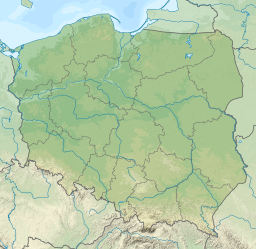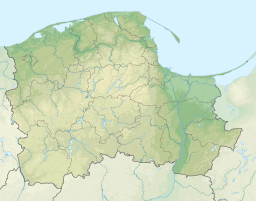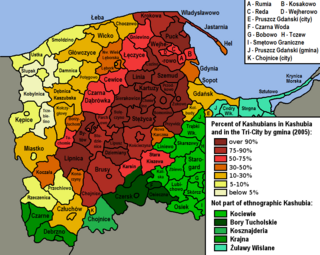
The Kashubians, also known as Cassubians or Kashubs, are a Lechitic ethnic group native to the historical region of Pomerania, including its eastern part called Pomerelia, in north-central Poland. Their settlement area is referred to as Kashubia. They speak the Kashubian language, which is classified as a separate language closely related to Polish.
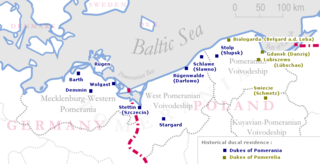
Pomerania is a historical region on the southern shore of the Baltic Sea in Central Europe, split between Poland and Germany. The central and eastern part belongs to the West Pomeranian, Pomeranian and Kuyavian-Pomeranian voivodeships of Poland, while the western part of Pomerania belongs to the German states of Mecklenburg-Western Pomerania and Brandenburg.

Żarnowiec is a village in the administrative district of Gmina Krokowa, within Puck County, Pomeranian Voivodeship, in northern Poland. It lies close to Żarnowieckie Lake, approximately 5 kilometres (3 mi) west of Krokowa, 23 km (14 mi) north-west of Puck, and 59 km (37 mi) north-west of the regional capital Gdańsk. In 2005 the village had a population of 861.

Slovincians, also known as Łeba Kashubians, is a near-extinct ethnic subgroup of the Kashubian people, who originated from the north western Kashubia, located in the Pomeranian Voivodeship, Poland, from the area around the lakes of Łebsko and Gardno. In the aftermath of World War II, Slovincians emigrated en masse to Germany, with the last families emigrating there in the 1980s. They originally spoke the Slovincian language, which went extinct in the early 20th century, as well as Kashubian, Polish, and German.

The Wda is a river in Poland; it has a lowland character. The Wda is one of the 15 main canoe trails in Poland. It is 198 km long and the surface of its catchment area amounts to 2325 km2. The Wda's average gradient is 0.7‰ and its flow is 6.52 m3/s.

Sobieszewo Island is an island on the Baltic Sea, between the Gdańsk Bay and the delta of Vistula river. The island is part of the territory of the city of Gdańsk, Poland.
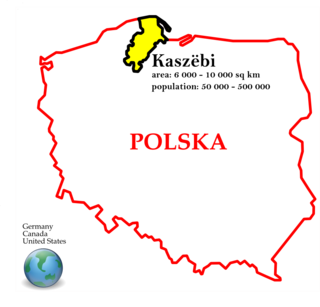
Kashubia or Cassubia is a language area in the historic Eastern Pomerania (Pomerelia) region of northern Poland. The unofficial self-description of "capital city of Kashubia" has long been contested by Kartuzy and Kościerzyna.
Wawrzyniec Samp is a Polish sculptor and graphic artist.
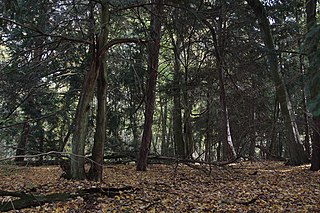
The Tuchola Forest, also known as Tuchola Pinewoods or Tuchola Conifer Woods, is a large forest complex near the town of Tuchola in northern Poland, which lies between the Brda and Wda Rivers, within the Gdańsk Pomerania region. The largest towns in the area are Czersk and Tuchola.

Gdańsk Pomerania, Kashubian: Gduńsczim Pòmòrzã, German: Danziger Pommern) is a geographical region within Pomerelia in northern and northwestern Poland, covering the bulk of Pomeranian Voivodeship.
Gmina Karsin is a rural gmina in Kościerzyna County, Pomeranian Voivodeship, in northern Poland. Its seat is the village of Karsin, which lies approximately 24 kilometres (15 mi) south of Kościerzyna and 69 km (43 mi) south-west of the regional capital Gdańsk.
Gmina Kościerzyna is a rural gmina in Kościerzyna County, Pomeranian Voivodeship, in northern Poland. Its seat is the town of Kościerzyna, although the town is not part of the territory of the gmina.
Gmina Lipusz is a rural gmina in Kościerzyna County, Pomeranian Voivodeship, in northern Poland. Its seat is the village of Lipusz, which lies approximately 14 kilometres (9 mi) west of Kościerzyna and 64 km (40 mi) south-west of the regional capital Gdańsk.

Wdzydze Kiszewskie is a village in the administrative district of Gmina Kościerzyna, within Kościerzyna County, Pomeranian Voivodeship, in northern Poland. It lies approximately 13 kilometres (8 mi) south of Kościerzyna and 61 km (38 mi) south-west of the regional capital Gdańsk.

Iwiczno is a village in the administrative district of Gmina Kaliska, within Starogard County, Pomeranian Voivodeship, in northern Poland. It lies approximately 3 kilometres (2 mi) south-east of Kaliska, 22 km (14 mi) south-west of Starogard Gdański, and 60 km (37 mi) south-west of the regional capital Gdańsk. It is located within the ethnocultural region of Kociewie in the historic region of Pomerania.

Kashubian Lake District (314.51) is a mesoregion part of the Eastern Lake District macroregion, the northernmost of all Pomeranian lake districts. Nearly of the lakes lie at a height from 149 to 216 metres above sea level. The mesoregion is largely populated by Kashubians, from which the name of the region originates. However, because Kashubians also live in the nearby mesoregions, the alternative name for the lake district is the Kartuskie Lake District.

Raduńskie Lake - a ribbon lake located in the Kashubian Lake District, in the Kartuzy County, part of the Kashubian Landscape Park. The lake is formed in a post-glacial valley, through which the River Radunia flows through. The lake is located in a region known as the Kashubian Switzerland.

Beheading the Kite is a Kashubian Midsummer Eve custom of ritually beheading a kite, a bird which in the Kashubian region used to symbolize evil. Since mid-19th century the ritual has become a part of Midsummer Eve, Whit Sunday or Corpus Christi celebrations. After all the residents have gathered, the village elder and village council publicly condemned the captured kite, blaming it for evil deeds, and sentenced it to death by beheading. Whenever a kite could not be captured alive, a hen or a crow could be used instead.

Kashubian literature appeared in Poland during the second half of the nineteenth century with Florian Cejnowa (1817–1881), who used the Sławoszyno dialect of the Puck region, and Hieronim Derdowski (1852–1902), who used the Wiele dialect of the Chojnice district. The latter enriched Kashubian literature especially in poetry.
Krubans, also known as Zaborans, is an ethnographic group of Kashubian people, originating from southeastern part of Kashubia, known as Zabory, located in the Pomeranian Voivodeship, Poland. They inhabit the gminas (municipalities) of Dziemiany and Karsin of the Kościerzyna County, and the Gmina Brusy of Chojnice County.


